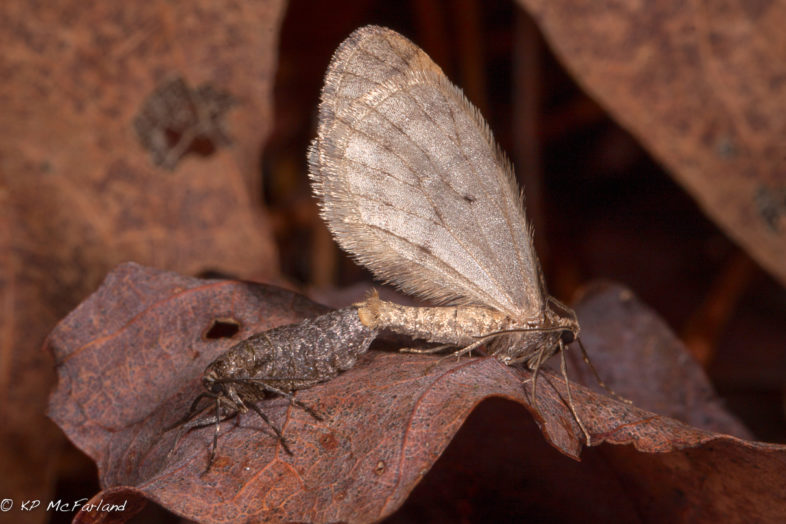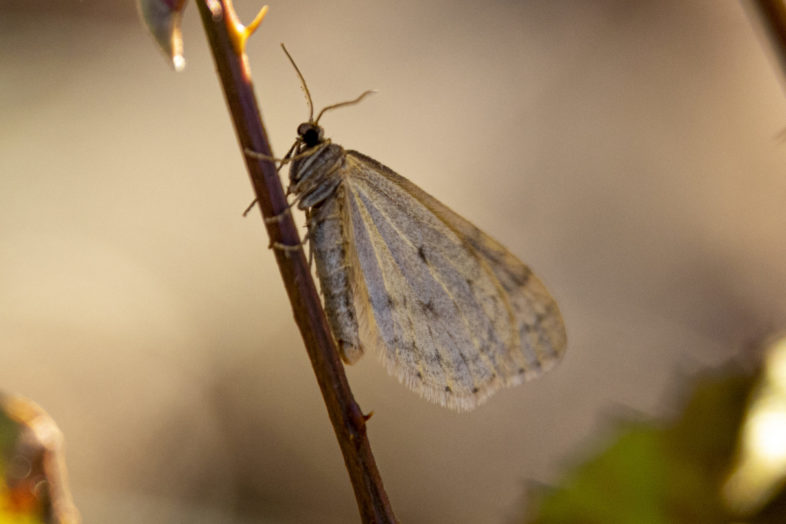
Bruce Spanworm (Operophtera bruceata) is one of the inchworms, a member of the large moth family called Geometridae (which means “earth-measuring”). / © K.P. McFarland
On even the darkest, coldest days of November, there are still signs of lepidopteran life if one looks close enough. Two moth species of the genus Operophtera, known as the Bruce Spanworm Moth (O. bruceata) and the introduced Winter Moth (O. brumata) manage to survive in conditions that would kill most other moths and butterflies. Dressed in shades of light brown and as small as a penny, these moths are easy to overlook, but what they lack in visual appeal they make up for in their fascinating natural history.
In this episode of Outdoor Radio, Kent McFarland and Sara Zahendra are hiking back and forth on a hillside, waiting for the morning sun to warm the forest so they can spot a flying male Bruce Spanworm moth. The females are wingless. They wait on the tree trunks wafting pheromones to attract a mate.
Listen to the show
Natural History Notes
- Incredibly, these moths can fly with air and body temperatures ranging from just 27 degrees Fahrenheit up to a balmy 77 degrees Fahrenheit.
- Males have one of the lowest wing-loads (total weight divided by wing area) of any moth measured. This both reduces the number of wing beats and lowers the energetic cost required to sustain flight.
- Female Bruce Spanworm Moth has no wings at all while the female Winter Moth retains vestigial, yet nonfunctional, wings on her back. When the females emerge in October and November, they laboriously crawl up the lower trunk of a host tree, where they solicit flying males with a chemical cocktail.
- Without bulky flight muscles weighing them down, females are able to dedicate over 60% of their total body weight to egg production, holding an average of 143 eggs.
- By late October and November, most of the insectivorous birds have migrated south and bats have migrated or gone into hibernation for the winter. With most significant moth predators out of the picture, these moths have free-reign.
Learn more
- View a map of Bruce Spanworm moth sightings, images and If you happen to spot one of these fascinating moths, snap a photo and submit your sightings to the Vermont Atlas of Life on iNaturalist.
- Learn more about these amazing moths at BugGuide.net and Wikipedia.com.

With the air temperature just reaching 32 F, Sara spotted this male glide out of the canopy and land in the forest understory. / © K.P. McFarland
Outdoor Radio is produced in collaboration with Vermont Public Radio.

fascinating great photo
Great piece for late fall. Fun, and full of observations of what we don’t see unless we slow down and take a close look!
I’m seeing these moths all through the woods right now, and I had no idea the females were flightless.